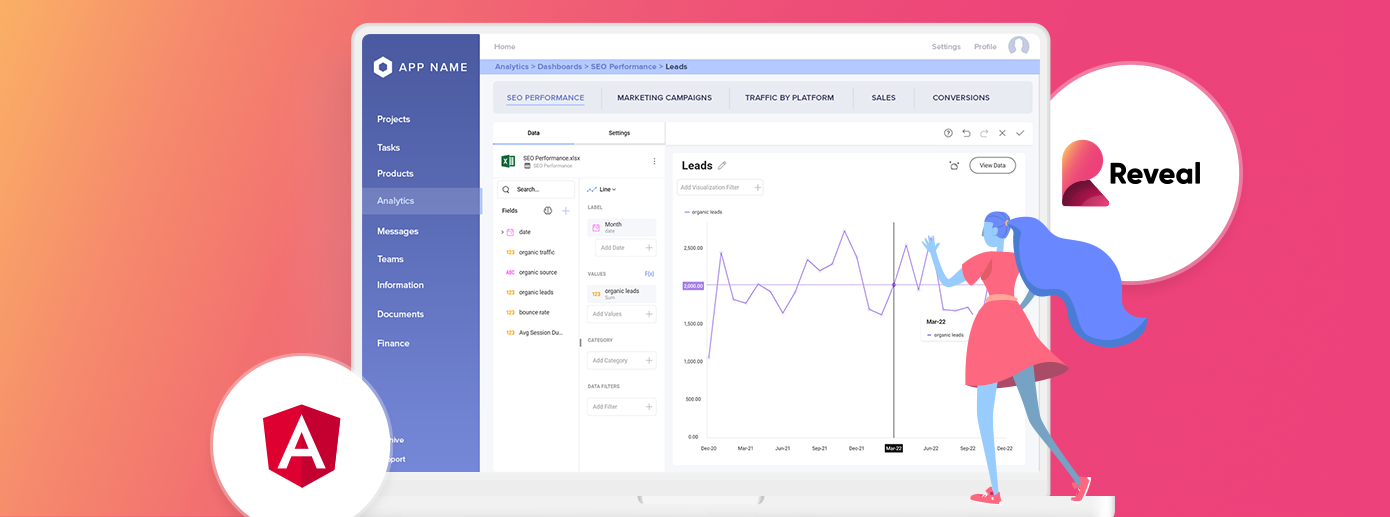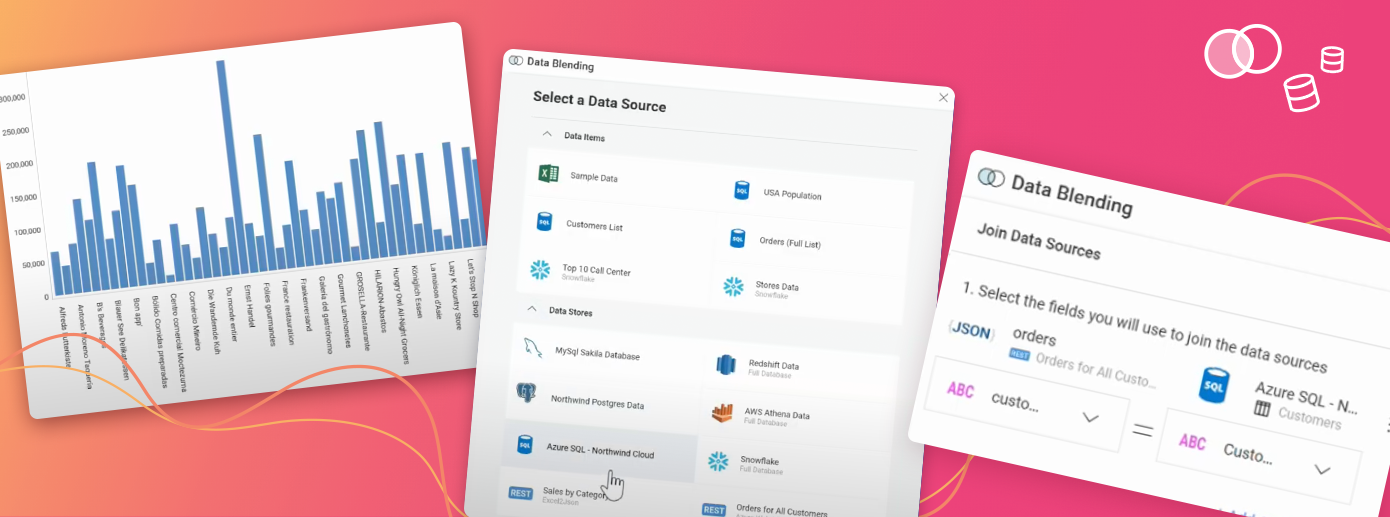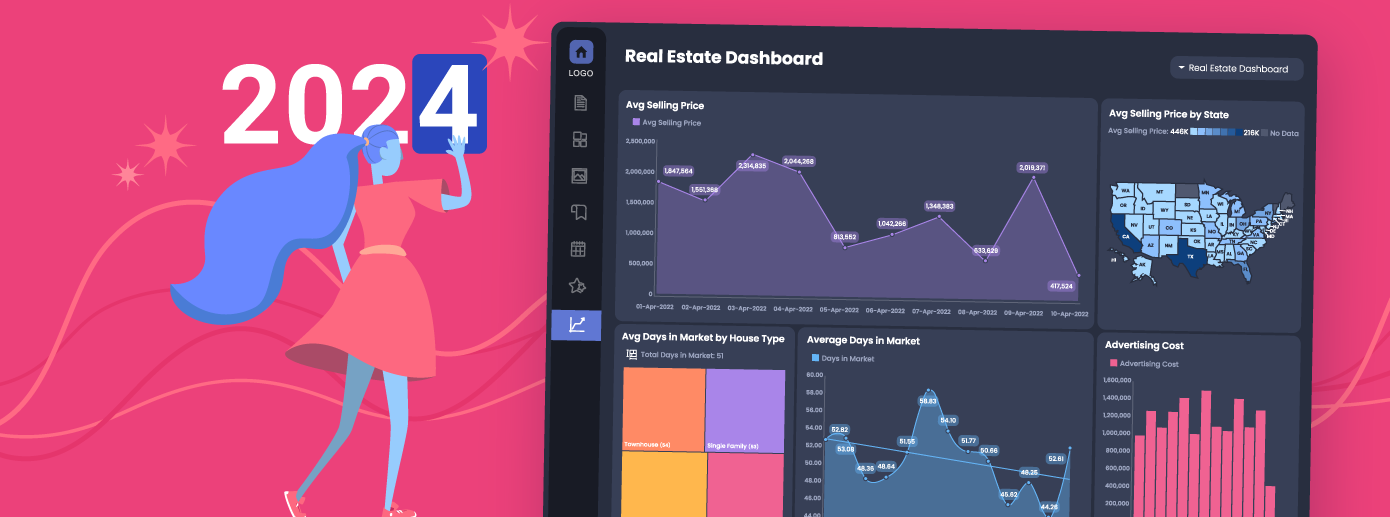

BI의 미래: 최고의 임베디드 분석 동향
즉석에서 결정을 내리기 위해 데이터의 잠재력을 최대한 활용하려는 조직은 수익을 늘리고 성장을 가속화하며 생산성을 향상시키기 위해 BI 및 데이터 분석 공간의 최신 트렌드와 기술을 지속적으로 따라야 합니다.
비즈니스 인텔리전스 (BI) 및 데이터 분석 세계는 매년 엄청난 변화를 겪고 있습니다.
스프레드시트는 마침내 숨겨진 보물을 산출하고 통찰력 있는 데이터 시각화 및 대화 형 고성능 대시보드로 발전했습니다.
데이터가 빅 데이터로 폭발했습니다.
모든 비즈니스 사용자가 데이터 분석에 액세스할 수 있게 되었습니다.
그리고 기업과 고객이 데이터를 사용하고 작업하는 방식이 많이 바뀌었습니다.
BI가 모든 규모의 조직에 없어서는 안 될 자산이 되었고 그 중요성이 계속 커질 것이라는 점에는 의심의 여지가 없습니다.
즉석에서 결정을 내리기 위해 데이터의 잠재력을 최대한 활용하려는 조직은 수익을 늘리고 성장을 가속화하며 생산성을 향상시키기 위해 BI 및 데이터 분석 공간의 최신 동향과 기술을 지속적으로 따라야 합니다.
그래서, 무엇이 올까요?
다음은 BI의 미래를 형성할 최고의 임베디드 분석 트렌드입니다.
주요 임베디드 분석 동향
- 상황에 맞는 분석
- 데이터 중심 데이터 분석
- 향상된 데이터 품질
- 클라우드 기반 BI 채택
- 로우코드 개발 도구
- 협업 BI
- 증강 분석
- 임베디드 AI가 미래다
- 효과적인 거버넌스
- 떠오르는 스토리텔링
- 교차 기능 임베디드 분석
1. 상황에 맞는 분석
Gartner의 "12 Data and Analytics Trends to Keep on Your Radar" 보고서에 따르면 2025년까지 컨텍스트 기반 분석 및 인공 지능(AI) 모델이 기존 데이터를 기반으로 구축된 기존 모델의 60%를 대체하고 비즈니스 사용자의 의사 결정을 개선할 것입니다. - 만드는 과정.
컨텍스트 분석 또는 컨텍스트 강화 분석은 최종 사용자의 이익을 위해 데이터를 보다 컨텍스트화하고 개인화하기 위해 분석 기능과 분석 기능이 포함된 비즈니스 애플리케이션을 병합하는 것입니다. 데이터 자체가 제공해야 하는 전체 가치를 항상 제공하지는 않습니다. 사람들이 원시 수치를 볼 때 데이터 안에 숨어 있는 인사이트를 해석하고 이해하는 것이 어렵다는 것을 알게 되므로 의사 결정을 개선하는 데 전략적으로 사용할 수 없습니다.
실시간 상황별 분석을 통해 다양한 데이터 포인트와 데이터 포인트 자체 간의 관계를 사용하여 보다 심층적인 분석이 가능합니다. 사용자가 정보에 입각한 비즈니스 결정을 내리는 데 필요한 데이터를 얻기 위해 창과 응용 프로그램을 전환하지 않고도 유사성, 제약 조건, 경로 및 커뮤니티를 기반으로 상황의 컨텍스트를 식별할 수 있습니다.
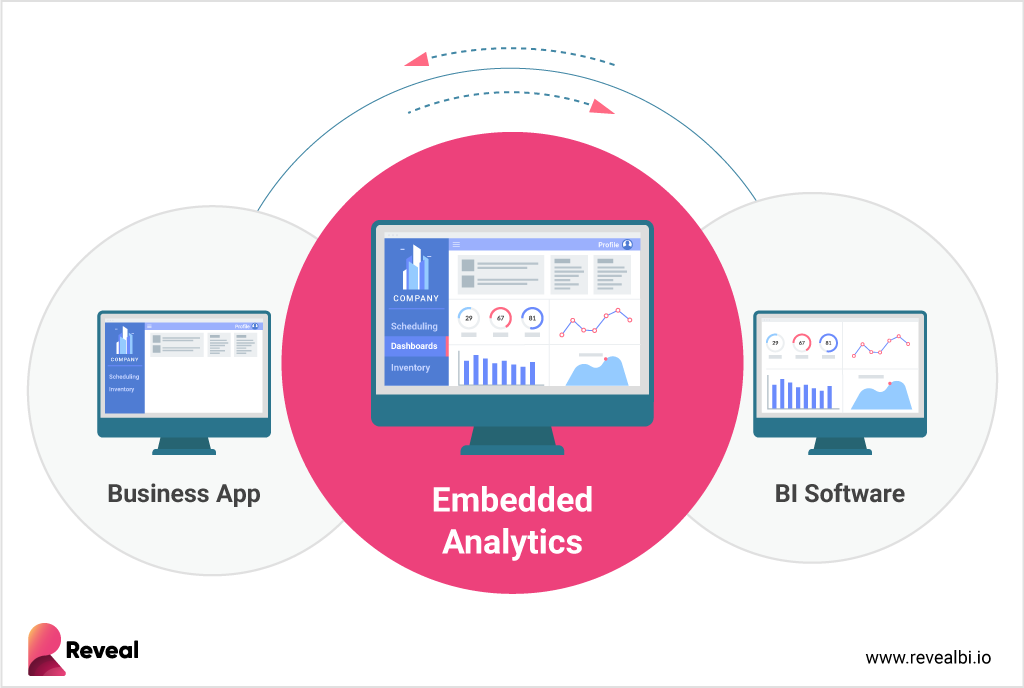
2. 의사결정 중심 데이터 분석
가장 크고 아마도 가장 중요한 임베디드 분석 트렌드 중 하나는 의사 결정 인텔리전스 분야에 초점을 맞추고 있습니다. 의사 결정 인텔리전스는 조직의 모든 비즈니스 의사 결정 및 프로세스가 데이터를 기반으로 한다는 것을 의미합니다.
데이터 기반 회사가 되려면 비즈니스에서 수집한 데이터를 최대한 활용하고 올바른 분석 도구로 처리하고 결과에서 실행 가능한 통찰력을 추출해야 합니다.
그리고 의사결정 인텔리전스의 가치가 새로운 소식은 아니지만 많은 기업들이 여전히 이를 향해 나아가지 않고 있습니다. 산업과 규모에 관계없이 기업은 소수의 선택된 사람들만 데이터와 통찰력에 액세스할 수 있도록 하는 것에서 모든 사람이 데이터 기반 의사 결정을 내릴 수 있도록 조직 전체에 데이터를 확산하고 액세스할 수 있도록 성장 전략을 변경해야 합니다. 영향.
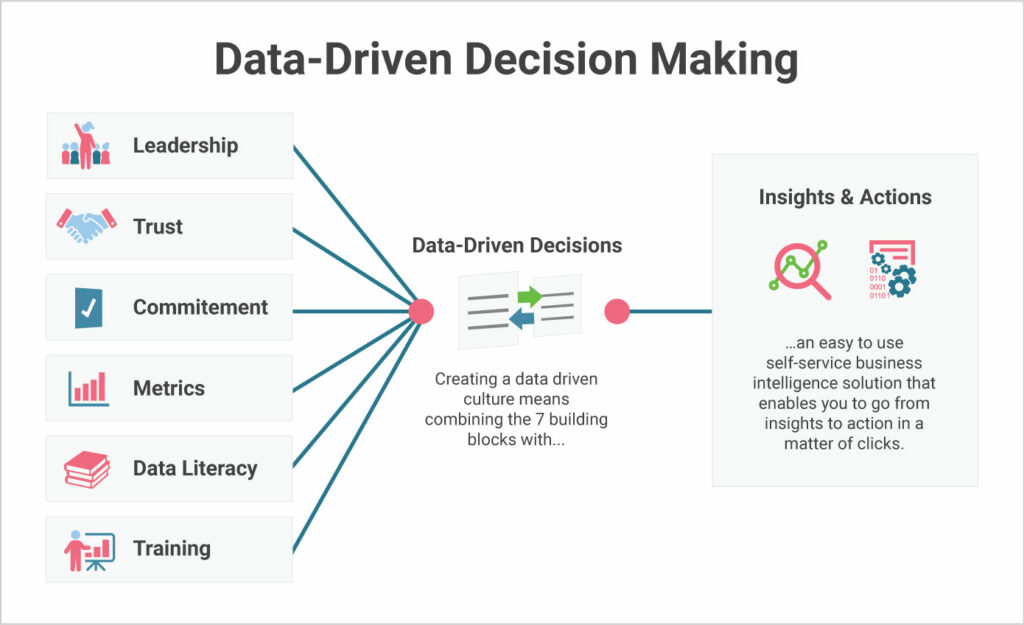
3. 향상된 데이터 품질
데이터 품질은 임베디드 분석의 가장 큰 과제 중 하나입니다. 데이터가 정확하고 일관되지 않으며 최신 상태가 아니면 전체 비즈니스 전략, 가치 및 수익성 기회를 손상시킬 수 있습니다. Gartner는 "데이터 품질을 개선하는 방법" 보고서에서 열악한 데이터 품질로 인해 조직이 매년 약 1,290만 달러의 비용을 지출한다고 추정합니다.
열악한 데이터 품질이 수익에 미치는 영향 외에도 데이터 생태계의 복잡성을 증가시키고 잘못된 의사 결정으로 이어집니다. 올바른 결정은 품질과 정확한 데이터를 기반으로 할 수 있습니다.
좋은 데이터 품질은 조직의 의사 결정을 안내하는 정확하고 일관되며 최신 통찰력을 얻으려고 할 때 매우 중요하며, 이러한 이유로 데이터 품질 관리 추세가 증가하고 있습니다. 데이터 품질 관리(DQM)는 기술, 프로세스, 조직 문화뿐만 아니라 적임자를 결합하여 모든 사용자가 혜택을 볼 수 있는 정확하고 유용한 데이터를 제공합니다.
4. 클라우드 기반 BI 도입
지난 2년 동안 원격 작업이 널리 채택되면서 클라우드 기반 BI 채택은 현재 임베디드 분석의 가장 큰 추세입니다. 분석 모델, 데이터 소스, 데이터 스토리지 및 컴퓨팅 성능을 포함한 거의 모든 BI 및 데이터 분석 요소는 이미 클라우드로 이동하여 위험을 줄이고 유연성을 높였습니다.
클라우드 기반 BI를 사용하면 언제 어디서나 모든 장치에서 데이터 및 분석 애플리케이션에 액세스할 수 있습니다. 이를 염두에 두고 임베디드 분석을 처음 사용하고 협력할 공급업체를 찾고 있는 경우(또는 더 나은 적합성을 위해 현재 공급업체를 떠나려는 경우) 클라우드 기반 배포를 지원하는 임베디드 분석 플랫폼을 선택해야 합니다. 각 플랫폼의 특정 기능을 활용하고 우수한 사용자 경험을 제공하는 기본 SDK를 모델링하고 제공합니다.
5. 로우코드 개발 도구
기술 리소스를 많이 사용하지 않고도 엔드 투 엔드 임베디드 분석 솔루션을 만들 수 있다는 것은 앞으로 몇 년 동안 주목해야 할 최고의 임베디드 분석 트렌드 중 하나입니다.
Reveal의 2022년 보고서에 대한 상위 소프트웨어 과제에 따르면 시민 개발자와 로우 코드 도구는 완전한 기능을 갖춘 애플리케이션을 더 적은 리소스로 더 빠르게 구축하려는 요구를 충족하는 데 도움이 될 수 있습니다. 설문 조사 응답자의 54%는 2022년에 많은 개발자/IT/분석가 프로세스를 자동화하는 로우 코드/노 코드(앱 빌더) 도구를 사용하여 비용을 절감할 계획이며 동시에 새로운 온디맨드 직원을 고용할 필요가 없습니다. .
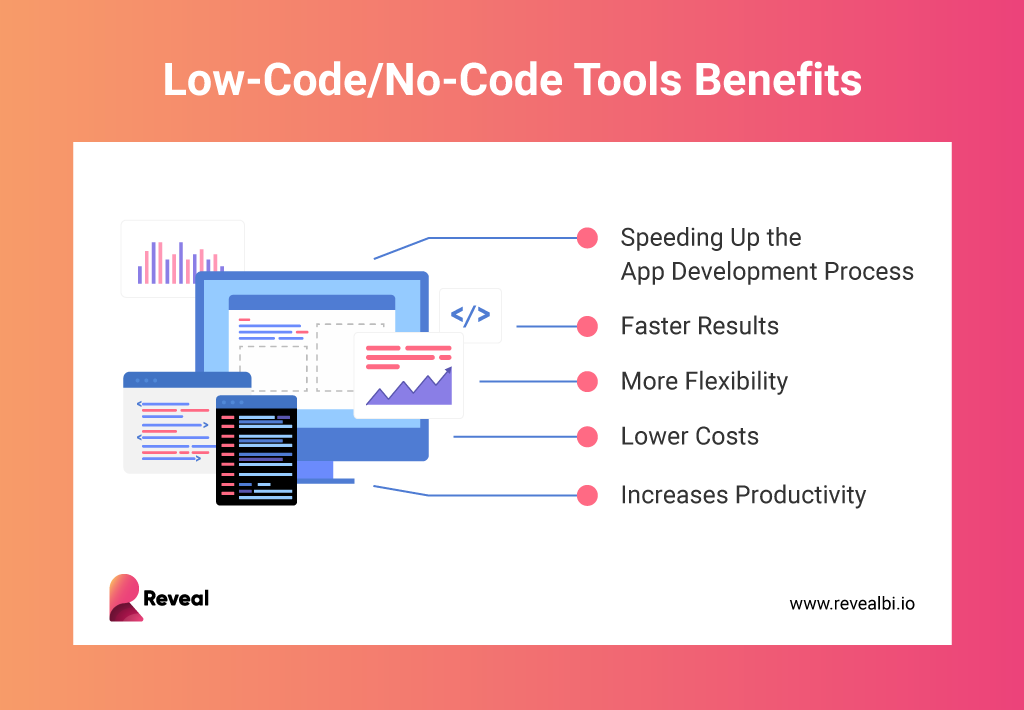
6. 협업 BI
협업 BI는 임베디드 분석 공간에서 완전히 새로운 추세는 아니지만 분산된 팀이 표준이 되면서 원격 협업이 그 어느 때보다 중요해졌습니다.
Collaborative BI는 기존의 BI 도구를 실시간 상황별 토론, 보고서 및 대시보드를 내부 및 외부 팀 구성원 및 이해 관계자와 쉽게 공유할 수 있는 협업 도구 및 기능과 결합하고 효율적인 의사 결정을 지원하는 설명 및 토론 기능을 제공합니다. 외부에서 주요 비즈니스 데이터에 쉽게 액세스할 수 있으며 의사 결정 프로세스에 관련된 모든 사람에게 더 큰 가시성을 제공합니다.
7. 증강 분석
글로벌 IT 리서치 회사인 Gartner에 따르면 증강 분석은 주목해야 할 최고의 데이터 분석 트렌드 중 하나입니다. 두 가지 최고의 분석 기술인 AI와 기계 학습으로 구동 되는 증강 분석을 통해 사용자는 상황에 맞는 수준에서 데이터를 더 쉽게 준비, 분석, 시각화 및 상호 작용할 수 있습니다.
증강 분석을 통해 사용자는 대화형 언어를 사용하여 데이터를 탐색하여 질문을 하고 자동으로 통찰력을 생성할 수 있습니다. 따라서 AI와 ML이 우리의 일상 생활에서 더 밀접하게 얽히고 우리를 둘러싼 현실 세계에 계속해서 큰 영향을 미치게 됨에 따라 데이터 준비, 자연 언어 인터페이스 및 안내 권장 사항.
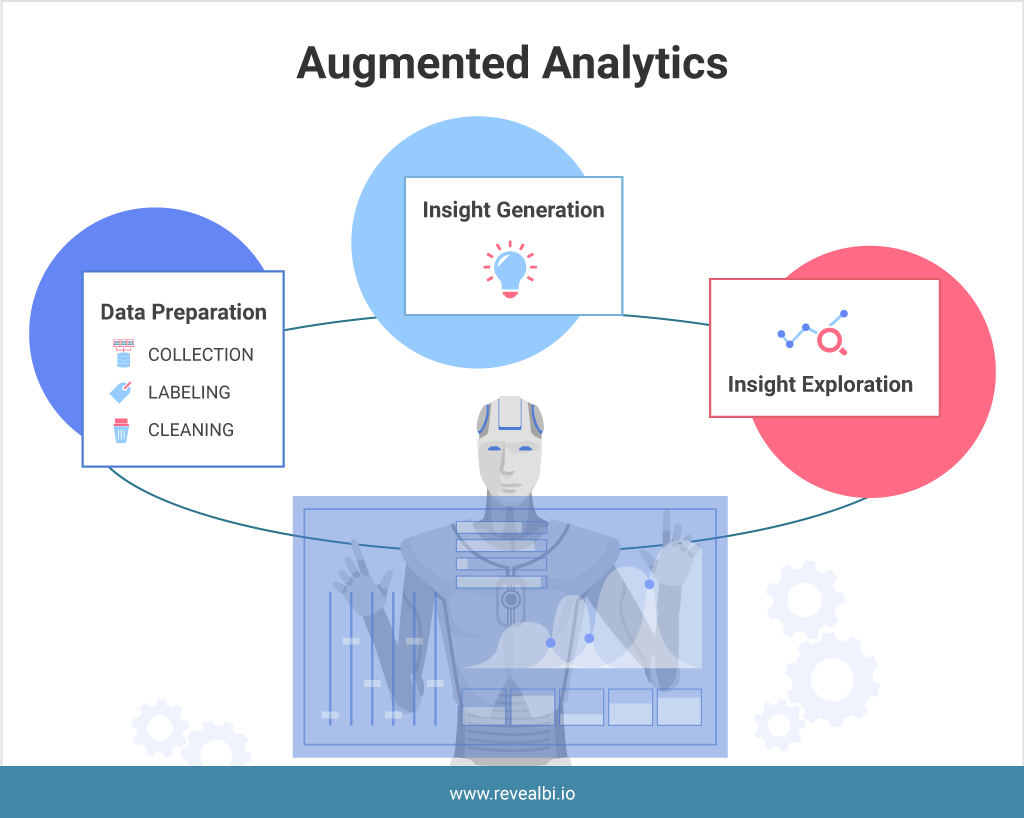
8. 임베디드 AI는 미래다
인공 지능(AI)은 일반적으로 인간 지능이 필요한 작업을 수행할 수 있는 스마트 머신을 구축하는 과학입니다. BI로 강화된 임베디드 분석은 조직에서 데이터를 관리하고 분석하는 데 필요한 인력을 줄여줍니다.
AI 및 기계 학습 알고리즘은 데이터 패브릭 기능, 지능형 조직 데이터 카탈로그, AI 기반 데이터 정리, 셀프 서비스 데이터 준비 등을 생성하거나 제공함으로써 사용자가 분석 및 데이터 관리와 상호 작용하는 방식을 개선합니다.
- 예측– 보다 정확한 ML 모델을 얻거나 SQL 삽입을 위해 승인되지 않은 소스에서 오는 사기성 쿼리를 찾는 데 필요한 데이터를 예측합니다.
- 자동화- 속도를 높이고 수동 작업의 필요성을 방지하여 시간을 절약합니다.
- 최적화– 모범 사례를 개선하고 적용하는 새로운 방법을 제공합니다.
앞으로 몇 년 동안 조직은 AI 기반 시스템에서 훨씬 더 많은 것을 요구하기 시작할 것으로 예상되며 AI는 오늘날보다 훨씬 더 책임감 있고 확장 가능한 기술이 되기 위해 진화할 것입니다.
9. 효과적인 거버넌스
비즈니스 관리 시스템을 위한 데이터 준비 및 프레젠테이션에 중점을 둔 BI 및 분석 관리와 달리 데이터 거버넌스는 이러한 시스템의 실제 데이터와 가용성, 사용성, 무결성 및 조직의 데이터 보안 내부 데이터 표준 및 정책을 기반으로 합니다.
데이터 거버넌스는 역할 기반 액세스, 인증 프로토콜 및 감사를 통해 비즈니스 자산의 품질을 보장합니다. 데이터 관리, 모니터링 및 보호를 위한 규칙 및 프레임워크를 포함함으로써 데이터 거버넌스는 비즈니스 전략이 분석 프로세스로 변환되는 방식을 다루는 데이터 전략으로 필요합니다.
조직은 기존 운영 문제를 해결하기 위해 모든 수준에서 효과적인 데이터 거버넌스가 필요합니다. 이는 유연성과 확장성을 제공하고 영향력이 큰 전략적 비즈니스 문제와 항상 변화하는 시장 역학에 매우 빠르게 대응하기 때문입니다.

10. 떠오르는 스토리텔링
Gartner가 "CFO가 무시할 수 없는 4가지 데이터 및 분석 동향" 보고서에서 예측한 또 다른 임베디드 분석 동향은 2025년까지 데이터 스토리가 분석을 소비하는 가장 광범위한 방법이 될 것이며 스토리의 75%가 자동으로 생성될 것이라는 점입니다. 증강 분석 기술을 사용합니다.
데이터 기반 스토리텔링은 원시 데이터를 읽기 쉽고 이해하기 쉬운 스토리로 변환하여 사용자가 통찰력을 행동으로 전환하는 데 도움이 되는 기능입니다. 데이터 시각화 기술, 인포그래픽, 대시보드 및 기타 시각적 요소를 통해 데이터 통찰력을 전달하기 위한 구조화된 접근 방식입니다.
비즈니스에서 통찰력을 데이터 스토리로 전환하는 것은 비즈니스 사용자와 의사 결정자 모두가 추세를 확인하고 문제를 이해하거나 판매 전략, 웹 사이트 성능 또는 마케팅 캠페인이 수행되는 방식을 해석할 수 있기 때문에 매우 중요합니다. 데이터는 상황의 맥락에서 이해되어야 하기 때문에 그 자체로는 그러한 의미를 제공할 수 없습니다.

11. 다기능 임베디드 분석
지금까지 분석 도구는 비즈니스 애플리케이션 및 프로세스와 격리되어 타사 도구로만 제공, 액세스 및 사용되었습니다. 이러한 불편으로 인해 대부분의 비즈니스 사용자는 제공된 분석 기능을 실제로 활용하지 않았으며 그 결과 주요 비즈니스 통찰력, 성장 및 수익 기회를 놓치고 있습니다.
Ventana Research에 따르면 2024년까지 사업부 직원의 2/3 이상이 워크플로 및 프로세스에 내장된 교차 기능 분석에 즉시 액세스할 수 있게 될 것입니다.
Reveal과 같은 내장형 분석 플랫폼의 등장은 기업이 분석 활동을 혁신하고 매일 더 지능적인 비즈니스 결정을 내리는 데 점점 더 많은 도움을 주고 있습니다. 더 빠르고 쉽고 효과적으로 말이죠.
마지막 말…
AI, 머신 러닝, NLP 및 기타 분석 기능의 등장으로 BI 환경 및 임베디드 분석 공간은 지속적으로 빠르게 발전하고 있습니다.
그리고 이러한 모든 분석 기술과 기능이 비즈니스 세계에서 점점 더 접근 가능해지고 중요해짐에 따라 모든 산업과 규모의 조직은 통찰력을 적시에 지능적으로 효과적으로 사용하기 위해 노력해야 합니다.
내장형 분석에 대한 자세한 내용과 이러한 도구가 비즈니스에 어떤 도움이 되는지 알아보려면 내장형 분석에 대한 최고의 가이드를 확인하십시오. 비즈니스 요구 사항에 적합한 공급업체를 선택할 때 어디서부터 시작해야 할지 모르겠다면 다음을 확인하십시오. 제품 핏 가이드.
Reveal 자세히 알아보고 실제로 어떤 이점을 제공하는지 확인하려면 Reveal SDK를 다운로드 하거나 빠른 제품 데모를 예약하세요.


